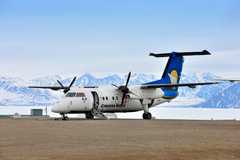Flights of fancy / Global
Effective cold relief
Passengers are merely one part of the equation for this Arctic airline: connecting isolated communities and ferrying food and fuel are just as high on the agenda.

Canadian North has been serving the Canadian Arctic for more than 80 years. The North American carrier is owned by 30,000 Inuit shareholders (the Inuvialuit and Inuit of Nunavut).
An extensive network of scheduled flights and cargo services is offered throughout Nunavut and the Northwest Territories, as well as charter operations in Canada and the US.
It also does the crucial job of linking small and remote communities that are often unreachable by road or sea during the winter.
Northern towns such as Clyde River, Cambridge Bay and Kungaaruk depend on its services, not just for passenger transport but also to receive cargo such as food and diesel.
But air passage to the High North is not always easy. Canadian North pilots often have to deal with poor weather, sometimes making last-minute decisions as to whether to attempt a landing. Even if they do manage to touch down there’s no guarantee they’ll be able to take off again; travellers often calculate additional travel days into their schedule to be able to make connecting flights.
Canadian North is based in Yellowknife in the Northwest Territories but one of its main hubs is the town of Iqaluit in the Nunavut Province. Daily flights operate between Ottawa and Iqaluit, from where smaller Dash airplanes connect the more remote communities. The company’s slogan is “Seriously Northern” and the logo is a polar bear and the midnight sun – two distinct features of the Arctic north of Canada.
“The company tries to employ as many Inuit as possible,” says marketing co-ordinator Jean Vivian. “The airline also offers substantial discounts to local people. In addition we provide different sponsorships and support special events, sports teams and school activities in remote communities.”
canadiannorth.com
Aircraft: Seven Boeing 737-200s, five Boeing 737-300s and four de Havilland Canada DHC-8-100 Dash 8s.
Number of employees: Approximately 800.
In-flight services: Snacks on all flights of less than an hour and light meals with free non-alcoholic drinks on longer journeys (Canadian beer and wine is for sale). Most flight attendants speak not only English but also the languages of the north, including Inuvialuktun, Inuktitut, Inuinnaqtun and French. Canadian North also publishes in-flight magazine Up Here.
Take a frosty flight
First Air
Kanata, Canada
First Air’s planes, including three new Boeing B737-400s introduced in the autumn, carry 225,000 passengers on scheduled and chartered services across 30 destinations in Canada’s north every year. No surprise then that the bulk of its fleet of 23 aircraft is retrofitted for icy landings.
The company, which generates CA$190m (€137m) in sales and pumps CA$40m (€29m) into the northern economy every year, has been strengthening its ties to the region.
That’s long been the case with in-flight magazine Above & Beyond, which proudly bears the tagline “Canada’s Arctic Journal”. For 25 years the publication has been keeping passengers abreast of the latest happenings, including everything from environmental issues to Inuit culture.
In 1990, the Inuit non-profit Makivik Corporation bought the company, transferring complete ownership to the 9,000 members of the First Nations group in northern Quebec. Today the company provides jobs for more than 1,000 people, 450 of whom live in the Arctic.
The airline transports some essential cargo to Arctic communities on its passenger planes: its two L382G Hercules aircraft are capable of carrying fire engines, among other things. In July, the airline renewed a five-year commitment with The North West Company to transport fresh produce and non-perishable food to the grocery chain’s 128 shops, ensuring that the larders of Canadian Arctic dwellers are well stocked.
firstair.ca


